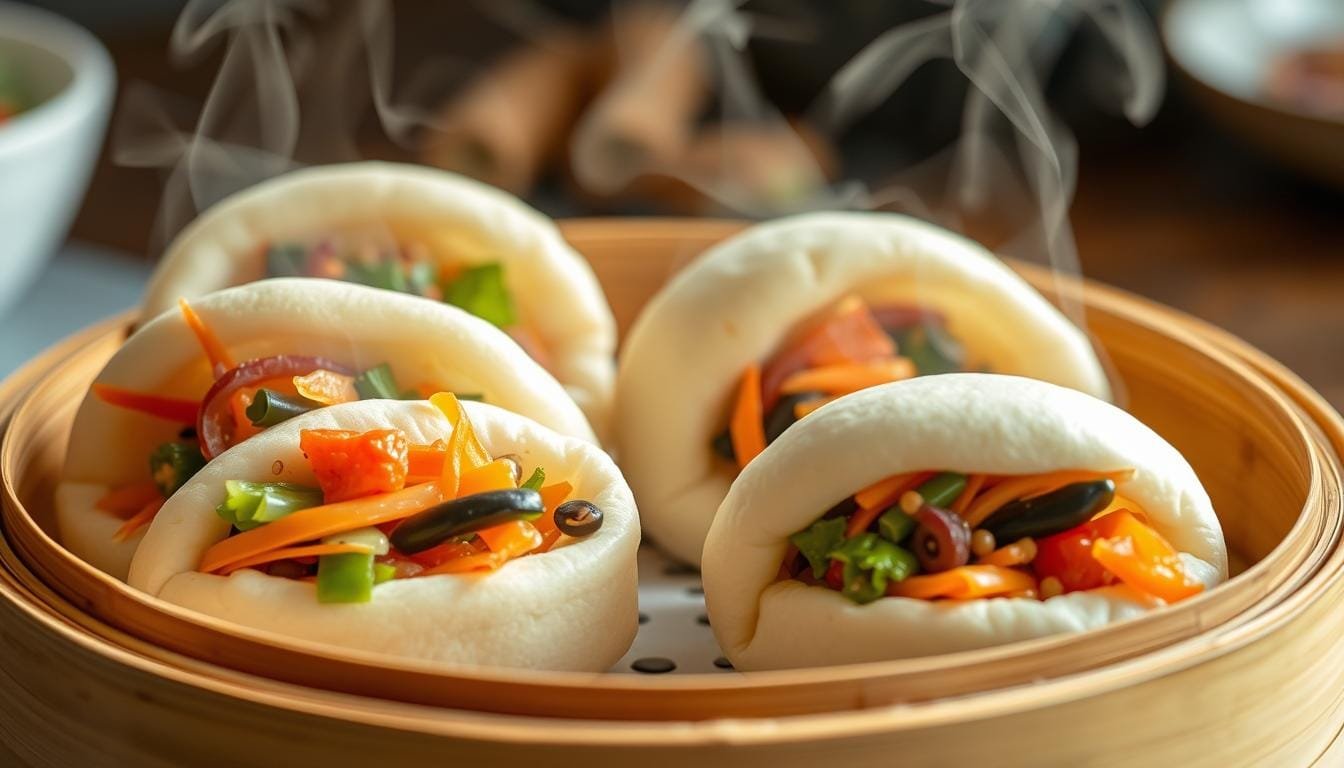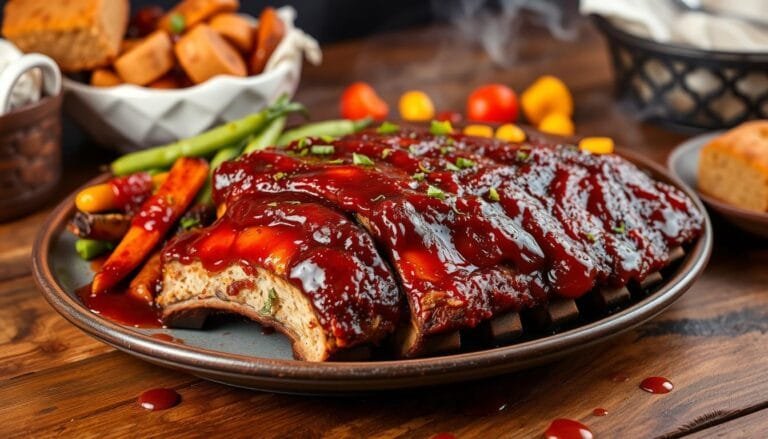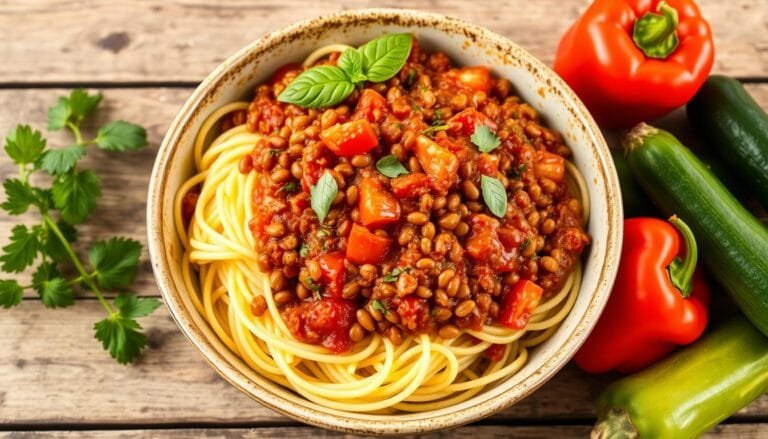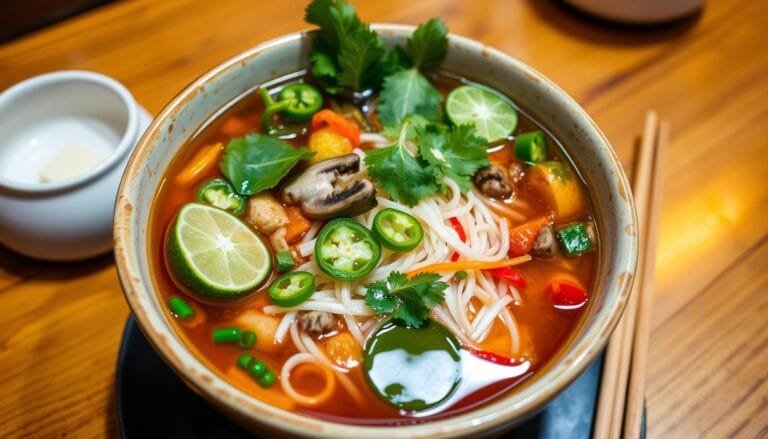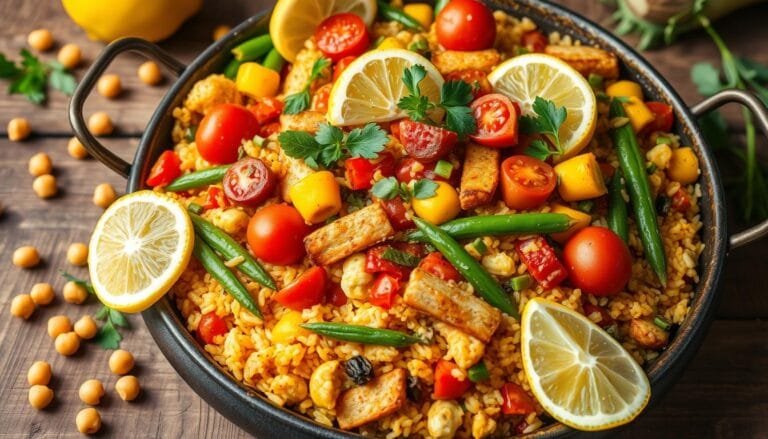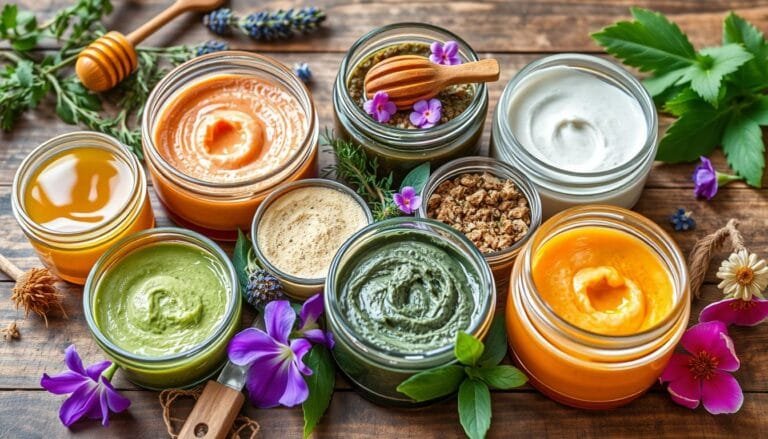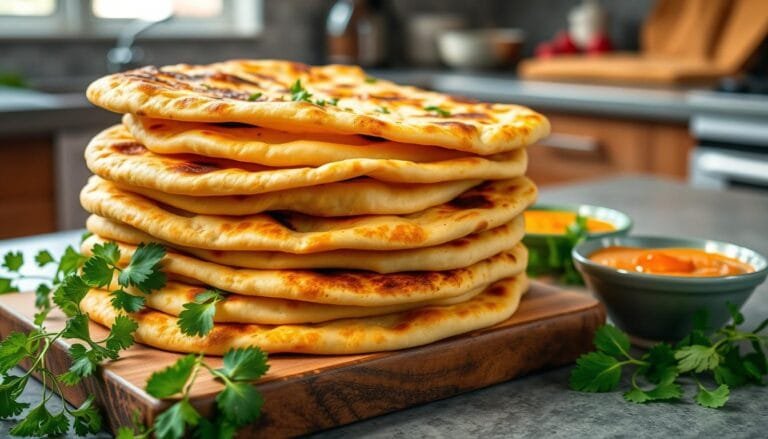I’m excited to share my vegan bao bun recipe with you. These steamed buns are soft, fluffy, and perfect for any filling. They’re great for both savory and sweet dishes, bringing authentic Asian flavors to your table.
The dough is easy to make with flour, yeast, baking powder, non-dairy milk, and oil. This mix creates a soft texture that’s a joy to eat. Shaping the buns is simple, and steaming them is quick. Soon, you’ll have hot, fluffy buns ready to fill and enjoy.
Let’s explore vegan Chinese cuisine together. Making these buns at home is fun and rewarding. You’ll impress everyone with your new skill!
What Are Traditional Bao Buns and Their Origins
Bao buns, also known as baozi, are a beloved Chinese bread enjoyed for thousands of years. These fluffy, steamed dumplings have a rich cultural history. They have evolved to include modern interpretations and vegan variations. Understanding their origins and significance offers insights into Asia’s diverse culinary landscape.
Types of Chinese Steamed Buns
Bao buns come in many forms, including plain and filled with sweet or savory ingredients. They are also shaped like folded lotus leaves. The dough is made from simple ingredients like flour, yeast, sugar, and water.
Cultural Significance of Bao
Bao buns are deeply rooted in Chinese cuisine. They are enjoyed at gatherings and parties, showing their social importance. Bao buns are a bit sweeter than regular bread, adding to their unique taste.
Traditional vs Modern Interpretations
Bao buns have evolved from traditional Chinese cuisine to include modern and vegan versions. These changes show the versatility of bao. It now caters to diverse dietary preferences, making it a beloved dish worldwide.
| Traditional Bao Buns | Modern Bao Buns |
|---|---|
| Made with simple ingredients like flour, yeast, sugar, and water | May incorporate plant-based or alternative ingredients for vegan versions |
| Typically filled with savory ingredients like pork, beef, or vegetables | Offer a wider range of fillings, including sweet options like chocolate or custard |
| Steamed or pan-fried to achieve a fluffy, pillowy texture | May be baked or use different cooking methods to create unique textures |
| Rooted in centuries-old Chinese culinary traditions | Adapted to cater to diverse dietary preferences and global palates |
https://www.youtube.com/watch?v=76MaKB2uLtI
Whether traditional or modern, bao buns captivate food lovers worldwide. They showcase the enduring appeal of Chinese culinary heritage.
Essential Ingredients for Vegan Bao Buns
To make delicious vegan bao buns, you need a few important plant-based bao ingredients. The dough is the base, made with plain flour, instant yeast, and baking powder. For a soft texture, we use unsweetened soy milk, a bit of neutral oil, and sugar.
Here’s a quick rundown of the essential vegan baking essentials you’ll need:
- Plain flour (all-purpose) – Around 280g (2.5 cups)
- Instant yeast – 3/4 teaspoon
- Baking powder – 1 teaspoon
- Unsweetened soy milk – 3/4 cup, warmed
- Neutral oil (e.g., canola or vegetable) – 3 tablespoons
- Sugar – 1 teaspoon
- Salt – 1 teaspoon
Getting the measurements right is key for fluffy plant-based bao. Use metric measurements for the best results. With these simple vegan baking essentials, you can make soft, pillowy bao buns from scratch.

“The secret to perfect vegan bao? It’s all in the dough. Get the ratio of flour, yeast, and liquid just right, and you’ll be enjoying soft, fluffy buns in no time.”
| Ingredient | Amount |
|---|---|
| Plain flour | 280g (2.5 cups) |
| Instant yeast | 3/4 teaspoon |
| Baking powder | 1 teaspoon |
| Unsweetened soy milk | 3/4 cup, warmed |
| Neutral oil | 3 tablespoons |
| Sugar | 1 teaspoon |
| Salt | 1 teaspoon |
Kitchen Tools and Equipment Needed for Steaming
Making delicious vegan bao buns requires the right tools. You’ll need a bamboo steamer, a big mixing bowl, and something to knead the dough. A bamboo steamer is best because it collects less moisture, keeping your buns soft.
Choosing the Right Steamer
The size of your bamboo steamer matters a lot. A 10-inch diameter steamer is perfect for most home cooks. Bamboo steamers can last a couple of years if taken care of. If you have a metal steamer, cover the lid with a towel or cheesecloth to stop moisture from falling on the buns.
Additional Tools for Preparation
- A rolling pin for shaping the buns
- Baking paper or parchment paper squares to line the steamer
- A tea towel or kitchen roll to prevent condensation drips
- A wok or frying pan to hold the steamer
- A scale for precise ingredient measurements
It’s key to line the steamer right to stop the buns from sticking. You can use a big piece of parchment paper or squares for different sizes. Yeasted buns need at least 1 inch of space to steam well without sticking.
After using, wash the bamboo steamer with mild soap and warm water, then dry it. Don’t put it in the dishwasher. If it’s dry, a bit of vegetable oil can prevent damage. Bamboo steamers are cheap, so it’s easy to replace them if needed.
Making the Perfect Bao Dough From Scratch
Making your own bao dough is very rewarding. It lets you learn Asian dough techniques and enjoy soft, fluffy buns. As a vegan bread lover, I’ve learned to make the best bao dough from scratch. I’m excited to share my tips with you.
To start, mix 300g of all-purpose flour, 3g of active dry yeast, 1 teaspoon of sugar, and a pinch of salt in a big bowl. Add 150ml of warm water slowly. Knead until the dough is smooth and slightly sticky.
After kneading, put the dough in a lightly oiled bowl. Cover it and let it rise for about 3 hours. It should double in size. Then, punch it down and knead briefly before shaping.
| Ingredient | Quantity |
|---|---|
| All-purpose flour | 300g |
| Active dry yeast | 3g |
| Sugar | 1 teaspoon |
| Warm water | 150ml |
With the right homemade bao dough, you’re ready to make tasty, vegan bread. Soon, you’ll learn how to shape and steam your bao buns perfectly!
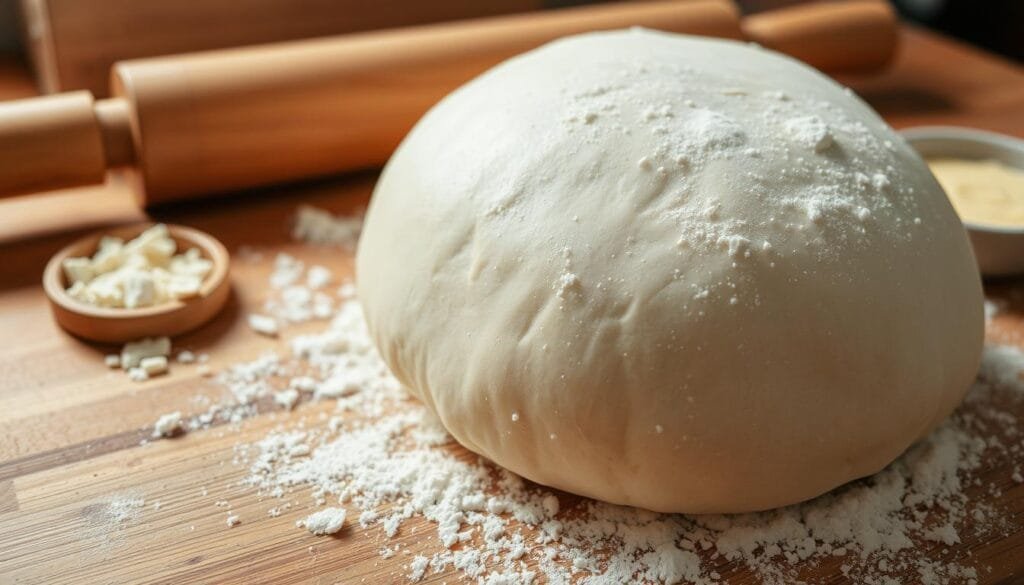
Step-by-Step Guide to Shaping Lotus Leaf Buns
Making perfect lotus leaf buns is an art in Chinese steamed bun making. It’s all about mastering the rolling and folding. This gives the buns their iconic shape and soft, fluffy texture. Follow this guide to make your bao buns look great every time.
Rolling and Folding Techniques
- Divide your bao dough into equal pieces, about 8 to 12 portions.
- Gently roll each piece into a smooth ball.
- Roll out each ball into an oval shape, about 1/2 cm thick, using a rolling pin.
- Brush the dough’s surface with a thin layer of oil or melted vegan butter.
- Fold the dough in half to make a semicircle shape.
- Place each folded bun on a small square of baking paper, ready for steaming.
Common Shaping Mistakes to Avoid
While the lotus leaf fold seems simple, there are common mistakes:
- Overflouring the surface: This can dry out the dough, making it hard to roll and fold.
- Rolling the dough too thin or too thick: Aim for an even 1/2 cm thickness for the best texture.
- Failing to seal the edges properly: Make sure to fully enclose the bun to prevent it from opening up during steaming.
Mastering bao bun shaping takes practice, but it’s worth it. Properly shaped lotus leaf fold buns will cook evenly and look beautiful.
Mastering the Steaming Process
Getting your bao buns perfectly steamed and fluffy is all about the technique. Whether you’re cooking steaming techniques, cooking bao buns, or making perfect steamed bread, it’s all about the right environment. This lets your dough rise and steam to perfection.
- Arrange the buns in the steamer, leaving enough space for them to expand.
- Let the buns rise for 30-40 minutes until they’re light and puffy.
- Place the steamer over a wok or pan filled with cold water. Make sure the water doesn’t touch the steamer’s bottom.
- Bring the water to a boil, then lower the heat to medium. Steam the buns for 10 minutes.
- After steaming, remove the steamer from the heat. Let the buns rest for 5 minutes without opening the lid. This step is key to keeping them fluffy.
The secret to perfect bao buns is to start with cold water. Let the buns warm up slowly with the water. This helps the dough cook evenly and get that fluffy texture.
“Steaming bao buns is an art form, and with the right technique, you can achieve bakery-quality results at home.”
By following these steps, you’ll get better at steaming bao buns. You’ll make perfect steamed bread every time.
Delicious Vegan Bao Buns Filling Ideas
Creating tasty plant-based bao fillings is key to making vegan Asian recipes everyone loves. You can choose from savory or sweet fillings for vegetable stuffed buns.
Mushroom and Vegetable Combinations
For a rich flavor, sauté oyster mushrooms with garlic, ginger, and spring onions. Add soy sauce, Gochujang, and sesame oil for extra taste. Roasted aubergine with curry, chili, and soy sauce is also great.
Try shredded cabbage, julienned carrots, and tofu for a tasty mix. These are all great plant-based bao fillings.
Asian-Inspired Sauce Pairings
- Hoisin sauce – a sweet and savory Chinese barbecue sauce that pairs beautifully with mushrooms or tofu
- Sweet chili sauce – a Thai-inspired condiment that adds a pleasant kick of heat and tanginess
- Peanut sauce – a creamy, nutty sauce that complements a variety of vegan Asian recipes
Play with different vegetable stuffed buns by mixing fillings and sauces. You can make many unique and tasty plant-based bao fillings.
| Filling | Calories | Servings | Preparation Time |
|---|---|---|---|
| BBQ Mushroom | 138 kcal | 2 | 30 minutes |
| Curried Aubergine | 125 kcal | 2 | 25 minutes |
| Cabbage, Carrot, and Tofu | 112 kcal | 2 | 20 minutes |

“The beauty of making plant-based bao fillings is the endless creativity and flavor combinations you can explore. Get ready to delight your taste buds with these delicious vegan Asian recipes!”
Storage and Freezing Tips
Keeping the fluffy texture and flavor of steamed bao buns fresh can be tricky. But, with the right storage, you can enjoy them for days or weeks. Bao buns are best eaten the day they’re made. But, if you have leftovers, they can stay fresh for 1-2 days in an airtight container.
To keep them longer, freezing is the best option. Let the buns cool down first. Then, put them in a sealed bag or container and freeze. Frozen vegan bao buns can stay fresh for weeks, keeping their taste and texture.
Reheating Frozen Bao Buns
When you’re ready to eat your frozen bao buns, let them thaw at room temperature. Then, steam them for a few minutes or microwave them for a few seconds. This will make them taste and feel like they’re fresh from the oven.
By using these easy bao storage methods, you can preserve steamed buns and freeze vegan bread for whenever you want. With a bit of planning, you’ll always have a delicious, fluffy bao bun ready to go.

“Properly stored, frozen vegan bao buns can last for several weeks, retaining their mouthwatering taste and soft, pillowy texture.”
Troubleshooting Common Bao Making Issues
As a seasoned home baker, I’ve faced a few common issues with vegan bao buns. But with some tips, you can easily solve these problems. One big issue is when the dough won’t rise. This usually happens if the yeast is old or the water is too cold.
Make sure to use fresh yeast and keep the water at 105-115°F. This helps the yeast work best.
Another problem is getting dry, tough buns. This often means you added too much flour. When kneading, add flour slowly and gently. This helps avoid sticky dough.
If your buns are deflating or soggy, it might be because you opened the steamer too soon. Wait at least 15 minutes before checking. Using a bamboo steamer helps cook evenly.
Uneven cooking can also be a problem. Make sure your buns are the same size and spaced well in the steamer. If the dough is too sticky, add a bit more flour slowly. Remember, weather and humidity can change dough texture, so adjust the recipe as needed.
With a bit of troubleshooting, you’ll soon be making perfectly fluffy bao buns, steamed bread, and vegan baking!
